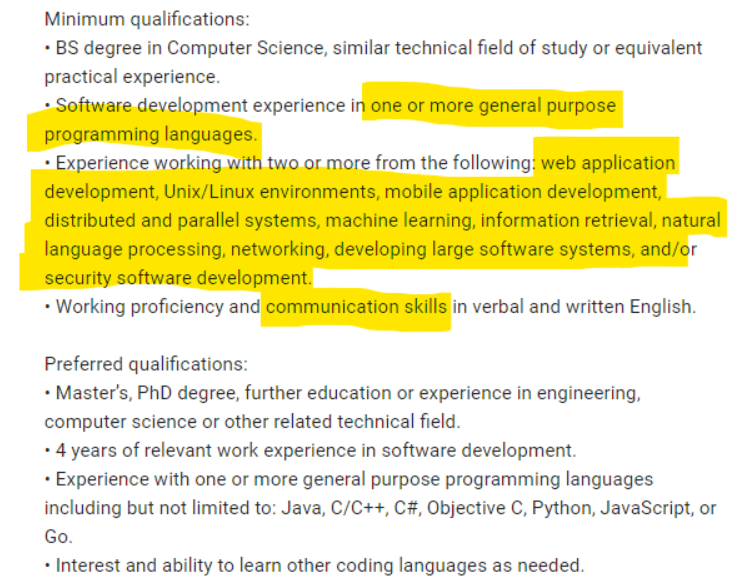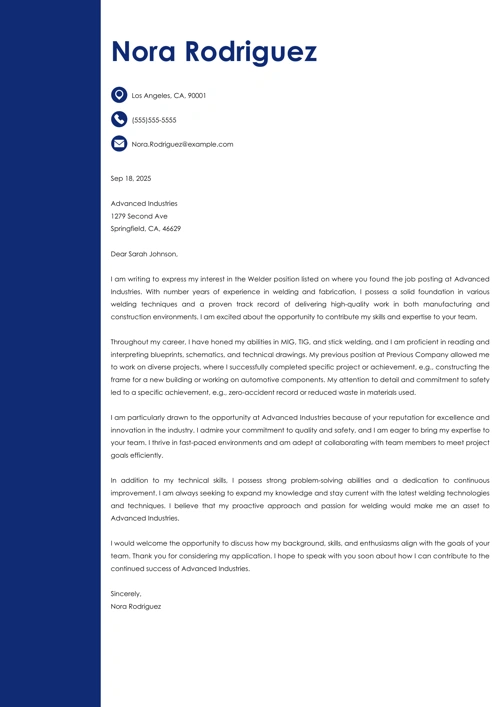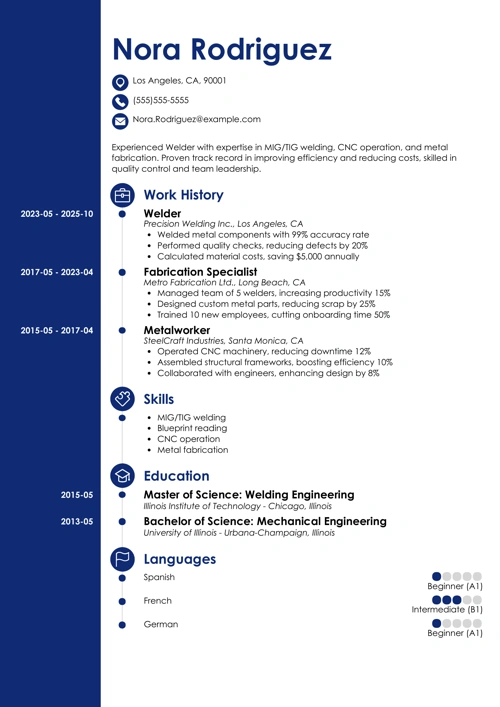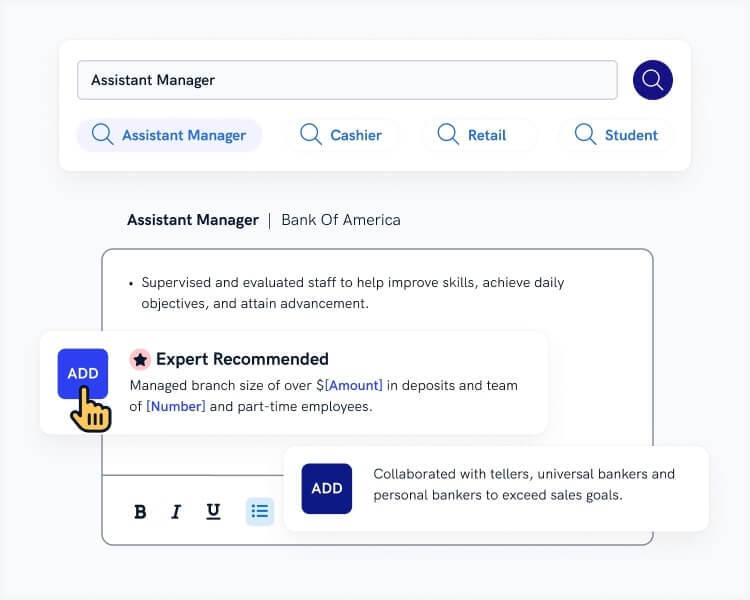You’re frantically scrolling through Google and scratching your head. You’ve just read that your dream job opportunity asks candidates to write a letter of intent. What on earth is that?!
You’ve heard of cover letters. Are they the same as a letter of intent for a job? Is it a different type of letter? Don’t worry, I’ll answer all of your questions.
This guide will show you:
- A letter of intent template you can adapt to fit your job search.
- How to write a letter of intent for a job that makes you stand out in the mob.
- The three key parts you need to make your letter zing.
- Several letter of intent examples that will maximize your chance of getting hired.
Want to write your letter of intent fast? Use our cover letter builder. See 20+ cover letter templates and create your cover letter here.
Sample Letter of Intent for a Resume—See more cover letter examples here.
One of our users, Valcia, had this to say:
Zety is an excellent resume and cover letter generator with excellent customer service. I love it!
Are you looking for a different kind of job application letter? Need more letter of intent templates? See these guides:
- Letter of Interest for a Job: Sample & Guide
- Letter of Intent vs Cover Letter: What's the Difference?
- Letter of Intent for Medical School: Example
- What is a Cover Letter? What is Its Purpose?
- CV vs Cover Letter: Difference
- Motivation Letter: Sample & Guide
- What is a Pain Letter & How to Write It
- Cold Call / Unsolicited Cover Letter: Sample & Guide
- Entry Level Cover Letter with No Experience
- How to Write a Cover Letter for a Job
What is a Letter of Intent?
A letter of intent is just a cover letter in most cases. It’s a 3–4 paragraph description of why you fit the job. It starts with a hook, shows a sampling of your achievements, and asks for the interview. In some cases, it can be used when there’s no job on offer. In that case it’s called a letter of interest.
What is the Purpose of a Letter of Intent?
The purpose of letters of intent is to get the hiring manager to notice us. A well-written resume helps a lot, but without an accompanying letter, it can seem like career spam. Conversely, if you’re applying to a job that hasn’t been advertised, write a letter of intent to kick off a relationship with the employer.
Let’s blow the doors off the other job candidates with a sample letter you can use:
Letter of Intent Template
Janet Metrick
Photographer, CPP
3093 Brown Avenue
Greer, SC 29650
803-840-7220
janetzmetrick@gmail.com
linkedin.com/in/janetzmetrick
7/7/20
Juanita Lanford
Marketing Director
Ansari Real Estate
4817 Algonquin Street
Greer, SC 29650
Dear Ms. Lanford,
As a skilled real estate photographer with 4+ years of experience creating over 9,000 stunning images of interiors and exteriors of million-dollar homes, I’m extremely interested in your photographer position at Ansari Real Estate. Your job posting says you’re looking for a strong leader who can deliver breathtaking real estate photos while also training photography assistants. I think you’ll be quite interested in my resume and especially these highlights:
As owner and photographer at Janet Metrick Photography, I’ve worked directly with two major realtor clients South Carolina and 200+ individual homeowner clients. I also trained a team of 4 assistant photographers in the best practices of real estate photography. I’m also a regular freelancer for Meredith Magazines, with dozens of images in Better Homes & Gardens and Home & Hearth Today. My equipment and skill set excel at capturing the tricky lighting balance between exteriors and interiors to provide a seamless image.
What draws me to Ansari Real Estate is your dedication to high-quality production. I’ve spent some time going through your website and print magazine, and I love the high standards you maintain. That said, I think my work can bring a new level of aesthetic perfection to your materials without adding extra cost. I’d be happy to meet with you next week to discuss how my technical ability and creativity can breathe new life into your website and print materials.
Best regards,
Janet Metrick
Photographer, CPP
803-840-7220
janetzmetrick@gmail.com
What makes that letter of intent stand out among the piles of job applications? It’s the three important parts it covers. Let’s run them down, one by one. But first—
How to Write a Letter of Intent
To write a letter of intent, research the company or school. Find out what they want most from a successful candidate. Then get their attention in paragraph #1, with the fact about you that fits their needs the most. Show more proof of skills in paragraph #2, and why you like them in paragraph #3.
Need more detail? Check out the quick tips below.
Here’s how to write a letter of intent:
1. Choose the Right Letter of Intent Format and Layout
Here’s the first hurdle—get them to read your letter. Letter of intent format matters because a poorly-laid-out letter is a clue you’re not right for the position. To combat that, make sure your font, line-spacing, paragraph-spacing, and margins are all clean and business-friendly.
Again, a letter of intent is the same as a cover letter, so follow basic cover letter structure with these tips:
- Use a standard cover letter outline for your letter of intent, with 3–4 paragraphs and a professional sign-off.
- Set your LOI’s cover letter line spacing at 1.15 for a sharp, clean look.
- Fix your margins at one inch on every side—left, right, top, and bottom.
- You’ll want a cover letter font that’s easy to read and not too fancy. Use one like Arial, Helvetica, Didot, or Cambria. Those have been around the block with good results.
Read more: Professional Cover Letter Design
2. Research the Company Before You Write
What’s the single most important thing you can do to make your letter of intent stand out? Research the company. It sounds boring, but it’s the single reason some letters make eyes pop while others get yawns. Why? Because research is like showing listening skills—it proves you know your stuff.
You don’t have to spend an hour on this. In fact, limit your research time to 15 minutes so you don’t bog down your job search.
To research a letter of intent for a job, check out:
- The job ad
- The company’s mission statement
- The company website
- Media articles about the company’s challenges, successes, awards, and lines of business.
Letter of Intent Sample—Researching the Job
Here’s a sample job posting (for a software engineer), with key parts highlighted:

Now you know a lot about what the company’s perfect employee looks like. When you write your letter, it’ll be 10x stronger because you took the time to learn their needs.
Pro Tip: Don’t stop at researching the job ad. Read their mission statement, and consider reaching out to a few people at the company on LinkedIn to get information.
3. Find 3 Ways You Fit the Position
Are you the perfect employee for the job? You’d better be. If not, they’ll never hire you. But how can you prove it? Once you’ve researched the company, it’s time to think about the ways you fit. The secret? Be as specific as possible, with numbers-based accomplishments in the skills they’re looking for.
Let’s look at an example:
Let’s say the company wants a photographer skilled in real estate photography and training. Jot down your accomplishments as follows:
Sample of Letters of Intent—Finding Ways You Fit
- Conducted 300+ real estate shoots
- Created 9,000+ real estate images
- Trained 4 assistant photographers
- Wrote 5 articles about real estate photography
- CPP certified
- Commended 4x by managers for efficiency
- Cut shoot costs by 20%
Notice anything? We’ve highlighted the ones that match the job the best in green. We’ll use those in our letter of intent. The others are great too, but we only need the best few in our letter. We’ll save the rest for our resume.
Now that you’ve found the top few ways you fit the position, it’s time to write your letter.
You should always custom-fit your letter of intent to the job. See our guide: Everything You Need to Know About Cover Letters
4. Get Attention with a Strong First Paragraph
“I didn’t read your letter.” What an insult! But it’s all too common. Why? Because most letters of intent start out like this: “I’m writing to express my interest in blah blah blah.” Uh-oh. You’ve lost the hiring manager. She’s thinking about camping out on the lake later with her kids. Don’t do that!
To make sure they read your letter, engage them with a strong first sentence and first paragraph.
Include:
- A professional cover letter salutation. Use the manager’s name if you can find it. A real name outshines a To Whom It May Concern every time.
- The number of years you’ve done this job (3, 5, 7+, etc.).
- Your most impressive, company-fitting accomplishment. If they want someone who’s great at flipping pancakes and you’ve flipped ten million pancakes, there you go.
- The top few qualifications they need for the position. This shows the employer that you’re aiming at the right target.
- A nod to your resume, and to the highlights you’ll share in the next paragraph—to keep them reading.
Let’s see how that works:
Letter of Intent Example—First Paragraph
| Right |
|---|
Dear Ms. Lanford, As a skilled real estate photographer with 4+ years of experience creating over 9,000 stunning images of interiors and exteriors of million-dollar homes, I’m extremely interested in your photographer position at Ansari Real Estate. Your job posting says you’re looking for a strong leader who can deliver breathtaking real estate photos while also training photography assistants. I think you’ll be quite interested in my resume and especially these highlights: |
| Wrong |
|---|
I’m writing to apply for your photographer position, which I saw advertised on LinkedIn. I’ve been a photographer for 5 years, and have worked in various industries to deliver high quality work. I’m extremely efficient and hardworking, and I take pride in delivering the best quality photographs possible... |
See the problem?
The first of those letter of intent examples sells it. It starts out with a stunning fact. Then it mentions the company by name, and moves on to what the company needs. Now the hiring manager knows you fit the job and understand the job.
But that first example falls flat. It sounds like a generic cover letter, it’s braggy, and therefore boring.
Read more: How to Begin a Cover Letter
5. Show Achievements in Your Letter of Intent
“We loved your letter of intent and had to talk to you!” Can you make the hiring manager say that? Yep. That happens in your second paragraph. That’s where you take the best few resume accomplishments that stick you to the job like duct tape. They have to fit the job requirements and make jaws drop.
To show achievements, go back to your research. Look at the best three (or so) accomplishments that bolt you to the job. Then talk about them in the second paragraph of your letter of intent for business.
Here’s how it’s done right and wrong:
Letter of Intent for Business Example—Second Paragraph
| Right |
|---|
As owner and photographer at Janet Metrick Photography, I’ve worked directly with two major realtor clients South Carolina and 200+ individual homeowner clients. I also trained a team of 4 assistant photographers in the best practices of real estate photography. I’m also a regular freelancer for Meredith Magazines, with dozens of images in Better Homes & Gardens and Home & Hearth Today. My equipment and skill set excel at capturing the tricky lighting balance between exteriors and interiors to provide a seamless image. |
| Wrong |
|---|
I’ve worked as a photographer for three different marketing departments in the past ten years. My work has been featured in well-known magazines, including Costco Connection and Blueridge Outdoors. I’ve delivered over 20,000 professional photographs, including images for clients in the consumer packaged goods and automobile industries. My work recently received the John L. Papracki Award for journalism excellence. |
Wow. That second letter of intent sample actually shows an amazing photographer. So what’s wrong with it? Well—it’s got some great achievements. But it just doesn’t fit the job. You can almost hear the hiring team discussing it. “Yep, this one’s great, but that first one just fits our needs the best.”
Pro Tip: Do you have more than just a few achievements that really prove you fit the job? You can add another paragraph for those, right after paragraph #2.
Plus, a great letter of intent that matches your resume will give you an advantage over other candidates. You can write it in our cover letter builder here. Here's what it may look like:
See more cover letter templates and start writing.
6. Explain Why You’re Interested in Them
“Okay, so you’re a good fit. But why us? Will you stick around? Or will you jump ship as soon as you find something better, with more pay?” Yes, employers think that way. To soothe their fears, you have to show why they’re important to you. That comes in the third paragraph of your letter of intent.
To show why you care about the position, you can choose from:
- A way the organization will help advance your career goals
- How they’ll help you use your favorite job skills
- Ways you fit the company’s mission statement (you researched this, remember?)
- Something else you like about the company
Let’s look at how that works:
Letter of Intent for a Job Example—Third Paragraph
| Right |
|---|
What draws me to Ansari Real Estate is your dedication to high-quality production. I’ve spent some time going through your website and print magazine, and I love the high standards you maintain. That said, I think my work can bring a new level of aesthetic perfection to your materials without adding extra cost. |
| Wrong |
|---|
I really hope you’ll consider hiring me as your next photographer. I’m a hard worker and a fast learner, and I’m also skilled in portrait photography, Adobe Photoshop, and Lightroom. I’ve done several nature photography shoots and I’m very versatile. I’m also CPP certified by PPA. |
Huge difference.
That first letter of intent sample has it all. It shows you know a thing or two about the company, and you have respect for it. But the second one is too one-size-fits-all. The employer knows by reading it that you don’t really care about her needs.
Pro Tip: The more interest you show in the company, the stronger your letter. There’s a vast body of research that confirms the reciprocity of liking.
7. End Your Letter of Intent by Asking for Action
Yes, you have to ask. At the end of your third paragraph, come right out and request the interview. But there’s a special way to do it so it doesn’t come off sounding needy. Namely—offer to trade something in return. Don’t think you have anything to trade? Of course you do.
At the end of your last paragraph, add a call-to-action like the next of your letter of intent examples:
Letter of Intent Samples—Call to Action
| Right |
|---|
I’d be happy to meet with you next week to discuss how my technical ability and creativity can breathe new life into your website and print materials. |
| Wrong |
|---|
Thank you for your time. I look forward to hearing from you soon. |
See the difference? The first of those letter of intent samples offers to trade information for the interview. The second looks like you copy-pasted it from any given letter on the internet.
Read more: Best Ways to End a Cover Letter
8. Sign off with a Professional Closing
This part’s easy. But get it wrong, and you’ll look sloppy. Your letter of intent should end like any business letter—with a sign-off, signature, and name and contact info.
You can end with:
- Best regards,
- Kind regards,
- Sincerely,
- Best wishes,
Or other business-ready closings, then your name, written or digital signature, and contact info. Here’s an example:
Sign-Off in a Letter of Intent Example
| Right |
|---|
Best regards, Janet Metrick Photographer, CPP 803-840-7220 janetzmetrick@gmail.com |
| Wrong |
|---|
Warm regards, Janet Metrick |
What’s wrong with sample #2? Well—warm regards is a little too “huggy” for someone you’ve never met. And it’s missing your job title and closing contact information.
Read more: Modern Cover Letter Templates for Every Job
9. Create a Professional Heading for Your Letter of Intent
We’ve left the top of your letter of intent for last. You’ll need a header for it too, with address info and the date. Yes, you’ve got your contact info at the bottom. But—it’s customary to put it at the top as well. The header should look like any business letter or cover letter heading.
- Start at the top left with your name, job title, street address, and other contact info like your phone number, email address, and even your LinkedIn handle.
- Leave a blank line, then the date, and then another blank line. The date is important so the manager knows how fresh your letter of intent is.
- Add the hiring manager’s name, job title, company name, and street address too.
Letter of Intent Heading Example
Janet Metrick
Photographer, CPP
3093 Brown Avenue
Greer, SC 29650
803-840-7220
janetzmetrick@gmail.com
linkedin.com/in/janetzmetrick
7/7/20
Juanita Lanford
Marketing Director
Ansari Real Estate
4817 Algonquin Street
Greer, SC 29650
That heading has everything you need to look professional.
Key Takeaway
Here’s how to write a letter of intent for a job:
- Start by researching the company. What does the job ad say about their needs? Also see their mission statement.
- Format your letter of intent just like a cover letter—with three paragraphs and 1-inch margins.
- Use your first paragraph to hook the reader fast with your #1 accomplishment.
- In paragraph two, add more achievements that show you fit the job like hand-in-glove.
- Write a call-to-action in the last paragraph of your LOI.
Creating a resume with our builder is incredibly simple. Choose a resume template and follow our step-by-step guidance to have a professional resume ready in minutes.
When you’re done, our professional resume builder will score your resume and our ATS resume checker will tell you exactly how to make it better.
About Zety’s Editorial Process
This article has been reviewed by our editorial team to make sure it follows Zety's editorial guidelines. We’re committed to sharing our expertise and giving you trustworthy career advice tailored to your needs. High-quality content is what brings over 40 million readers to our site every year. But we don't stop there. Our team conducts original research to understand the job market better, and we pride ourselves on being quoted by top universities and prime media outlets from around the world.




